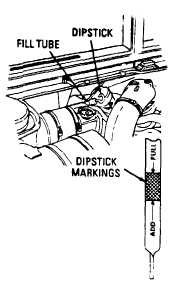TM 9-2320-280-20-1
REFERENCE INFORMATION
TRANSMISSION SYSTEM
(4L80-E)
Procedure for checking transmission fluid
1. Start engine
2. Hold down brake pedal and move transmission shift lever through all ranges including
raverse. Leave the lever in each range for 2 seconds.
3. Engage parking brake and place shift lever in neutral. Check fluid level on dipstick.
4. Proper level is between FULL and ADD marks on dipstick.
NOTE
Check fluid for a burnt small, grit, discoloration, air bubbles, or a milky appearance.
Burnt smell, discoloration, or grit indicates worn or damaged internal components.
Notify DS maintenance
Bubbles indicate an overfilled system or air leaks in the system. Drain the fluid and refill
to proper level. Refer to (para 5-2).
Milky appearance is due to water in the system. Change the fluid and filter.
Check fill tube for indications of fluid being blown out. If fluid is being blown out, cheek
vent line for obstructions, and refill transmission to proper level. Refer to (para. 5-2).
1. Position shift lever in (overdrive) and accelerate vehicle from 0 mph. A 1-2, 2-3 and 3-4 shift should occur at all
throttle openings. Allow vehicle to coast down to about 0 mph and 4-3, 3-2 and 2-1 shifts should occur.
2. Position transmission shift lever in "D" (drive) and accelerate vehicle from 0 mph. A 1-2 and 2-3 shift should occur at all
throttle openings. Allow vehicle to coast down to about 0 mph and 3-2 and 2-1 shifts should occur.
3. Position transmission shift lever in "2" (low two) and accelerate vehicle from 0 mph. A 1-2 shift should occur at all throttle
openings. No 2-3 shift can be obtained in this range. A 1-2 shift in 2 is somewhat firmer than in “D”. This is normal.
4. Position shift lever in "1" and accelerate the vehicle from 0 mph. No upshifts should occur in this range.
5. Position shift lever in and with the vehicle speed at approximately 45 mph, close throttle and move lever to "3".
Transmission should downshift to 3rd gear. An increase in engine rpm and engine braking effect should be noticed.
6. Position shift lever in "D" and with the vehicle speed at approximately 35 mph, close throttle and move lever to "2".
Transmission should downshift to 2nd gear. An increase in engine rpm and engine braking effect should be noticed.
7. Position shift lever "2" and with the vehicle speed at approximately 25 mph, close the throttle and move lever to "1".
Transmission should downshift to 1st gear. An increase in engine RPM and engine braking effect should be noticed.
8. Position shift lever in "R" and check for reverse operation.
9. Hard shifting may be indicative of an underfilled or dogged system.
The fan cut off switch and TP sensor are used to
shift the transmission to a lower gear under heavy
acceleration. The system also disengages the
engine cooling fan so as to allow maximum engine
power to be used for moving the vehicle.
2-413







